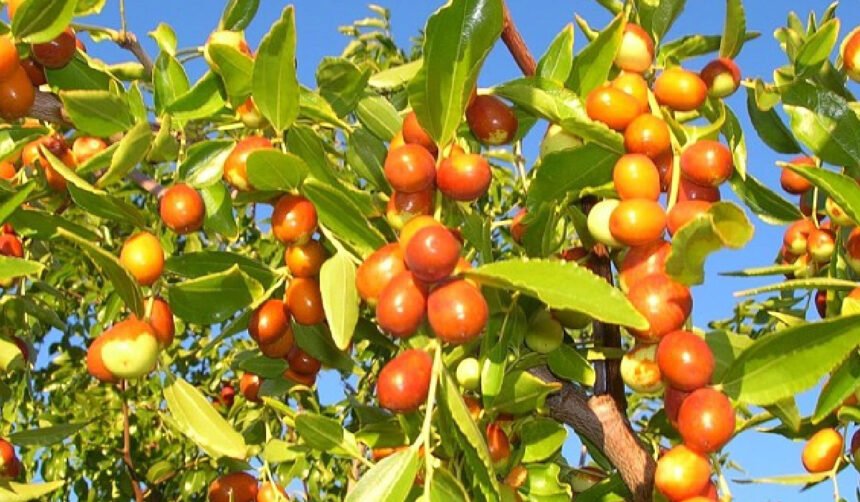What Are Žižole?
Žižole, also known around the world as jujube, Chinese date, red date, or unabi, are small but extraordinary fruits that grow on the Ziziphus jujuba tree. This fruit has the rare ability to transform its taste and texture dramatically—from crisp and apple-like when fresh to chewy, sweet, and date-like when dried. Its versatility doesn’t end at flavor alone. Žižole are packed with vital nutrients and antioxidants, making them both a culinary and medicinal powerhouse.
These fruits are popular not only in traditional Asian remedies but also in Mediterranean cuisines and modern wellness circles. Their resilience as a crop, long shelf life, and rich cultural history have allowed them to spread across continents and generations. Whether you’re enjoying them fresh off the tree in Dalmatia or sipping them in herbal tea in Beijing, žižole are truly a global fruit with timeless appeal.
Botanical Identity and Origins of Žižole
The scientific classification of žižole places it under the Rhamnaceae family, with its full botanical name being Ziziphus jujuba. The tree itself is a deciduous species that can take the form of either a large shrub or a small tree, depending on how it’s cultivated. It is most easily recognized by its thorny branches, glossy green leaves, and delicate yellow-green flowers that bloom in early summer.
The fruits are drupes—oval or round with a thin skin, crunchy flesh when unripe, and a single seed at the core. Originally domesticated in northern China over 4,000 years ago, the tree’s adaptability made it ideal for expansion along trade routes such as the Silk Road. As a result, žižole made their way to Korea, India, the Middle East, and finally to southern and eastern Europe, where they became a beloved part of local landscapes and traditions. In Croatia, Slovenia, and parts of Italy, the fruit is known as žižule or žižula, symbolizing both cultural heritage and agricultural sustainability.
How Žižole Look, Grow, and Taste
Žižole trees are prized not just for their fruits but also for their ability to thrive in challenging environments. Typically growing between 4 and 10 meters in height, they are highly drought-tolerant and capable of surviving in poor soils with minimal care. This makes them an ideal crop in arid or semi-arid regions, especially in countries facing increasing water scarcity. The tree’s physical features—shiny oval leaves, small yellow flowers, and thorny limbs—make it easily identifiable.
The fruit itself begins as green, firm, and crisp. As it matures, it transitions to a reddish-brown color and takes on a softer texture. When dried, žižole become deeply wrinkled, almost like a small date, but retain a unique balance of sweetness and mild tanginess that sets them apart from other dried fruits. This transformation in flavor and texture through its ripening cycle is what makes žižole so distinctive and loved in culinary uses worldwide.
Varieties of Žižole
There are several cultivated varieties of žižole, each with unique traits that cater to different culinary preferences and growing conditions. The ‘Li’ variety is one of the most popular, known for its large, round shape and extra sweetness—ideal for eating fresh. The ‘Lang’ variety, by contrast, has a more fibrous texture and is better suited for drying and long-term storage. ‘Honey Jar’ is a smaller variety but prized for its intense sweetness, making it perfect for snacking and candy substitutes.
‘Shanxi Li’ is another favorite, noted for its size and juicy, crisp flesh. Each variety offers a different experience, which is why farmers and home gardeners often choose according to climate, soil conditions, and desired use. The diversity among žižole cultivars also makes the fruit incredibly adaptable to different cultural recipes and processing techniques, whether for jams, teas, baked goods, or medicinal decoctions.
Žižole Through the Ages
Žižole have traveled through millennia of human history, cherished not only as a fruit but also as a symbol of well-being and resilience. In ancient China, žižole were considered sacred and medicinal, appearing in imperial texts and Traditional Chinese Medicine for their ability to calm the spirit, strengthen digestion, and nourish the blood. As the fruit journeyed westward, it was embraced by Indian Ayurveda and Siddha systems under the name “Elanthai,” where it served as a rejuvenative tonic. In Middle Eastern cultures, žižole were often boiled into syrups to treat respiratory and digestive conditions.
Once it reached Europe, especially the Mediterranean basin, žižole gained new life in folk traditions. In Dalmatia and Istria, the fruit became a seasonal staple, appearing in jams, dried snack platters, and even in homemade rakija (fruit brandy). In Bulgaria, known as хинап (khinap), it holds a nostalgic place in rural life. These wide-ranging uses across civilizations demonstrate the enduring appeal and cultural richness of žižole.
Nutritional Profile of Žižole
Žižole packs an impressive nutritional punch in a small package. A typical 100g serving of fresh žižole contains about 79 kcal, 20 grams of carbohydrates, and 2.6 to 10 grams of fiber, depending on ripeness. What truly stands out is the fruit’s exceptionally high vitamin C content—ranging from 69 to 80 mg per 100g—making it a natural immune booster. Potassium content hovers around 250 mg, supporting heart health and fluid balance.
The iron and calcium content is modest but beneficial, especially for individuals with nutritional deficiencies. In their dried form, žižole concentrate their sugars and calories but also their antioxidants, making them a powerhouse of natural energy and protection against oxidative stress. With lower sugar levels than dates but greater health-enhancing compounds like flavonoids and saponins, žižole are ideal for those seeking functional foods that are both enjoyable and beneficial.
Health Benefits of Žižole
The health benefits of žižole are well-documented across both traditional practices and modern nutritional science. First and foremost, their high vitamin C and antioxidant levels help bolster the immune system, fend off infections, and promote skin repair. Compounds like jujuboside A have been studied for their calming effects, supporting restful sleep and reducing symptoms of anxiety and stress. Their significant fiber content aids digestion, supports gut microbiota, and prevents constipation.
Beyond these, žižole are considered adaptogens—natural substances that help the body cope with stress and maintain balance. Regular consumption of žižole has also been linked to better cardiovascular health due to its potassium content and anti-inflammatory properties. Combined, these traits make žižole not only a delicious snack but a smart choice for anyone looking to support their overall well-being in a natural way.
Žižole in Traditional Medicine Systems
Across the globe, žižole have been part of healing traditions for centuries. In Traditional Chinese Medicine, they are referred to as a “tonic fruit” that harmonizes the spleen and liver, calms the mind, and builds qi (life energy). In Ayurvedic medicine, the fruit is considered sattvic—promoting clarity, calmness, and balance. It’s used to strengthen digestion, rejuvenate tissues, and support the nervous system.
European herbalism, particularly in the Balkans, continues to use žižole for teas and syrups aimed at reducing inflammation, treating colds, and calming nerves. These medicinal uses aren’t just anecdotal. Modern research supports many of these claims, especially in regard to the fruit’s antioxidant, sedative, and anti-inflammatory properties. This dual presence in both folklore and pharmacology underscores žižole’s enduring role as a fruit that bridges food and medicine.
Culinary Uses of Ži žole
Žižole are one of the most versatile fruits in the kitchen. When fresh, they can be sliced into fruit salads, served alongside cheese platters, or eaten straight from the tree. Their crisp texture and mild sweetness pair beautifully with yogurt, nuts, and honey. Dried ži žole are a snack on their own but also work well in trail mixes, muffins, or granola bars. In the Mediterranean, especially in Croatia, people make džem od žižula (žižole jam) and use it on bread or pastries.
Žižole tea, often brewed with ginger, cinnamon, and sometimes goji berries, is a popular remedy for sleep and digestion. For those interested in alcoholic creations, ži žole can be fermented or infused into rakija, a fruit brandy that retains the calming properties of the fruit. The modern health movement has even seen ži žole added to smoothies and superfood bowls, showcasing how ancient ingredients continue to inspire contemporary cuisine.
Žižole vs. Other Superfruits
When comparing žižole to other popular superfruits like dates, goji berries, and acai, they hold their own remarkably well. Dates are higher in sugar and calories but offer little vitamin C. Goji berries provide strong antioxidants but have a more intense and sometimes bitter taste. Acai is nutrient-dense but often comes in processed form like powders or frozen pulp. Žižole strike a balance between natural sweetness, high vitamin C, and usability in fresh, dried, or cooked forms. They are also lower in glycemic index, making them suitable for diabetics and those managing blood sugar. Thanks to their broad spectrum of health benefits and lower calorie count, žižole deserve a top spot among the world’s most valuable superfruits.
How to Add Ži žole to Your Daily Diet
Incorporating žižole into your daily routine is both simple and rewarding. Dried žižole can be tossed into a lunchbox, trail mix, or breakfast cereal for a nutritious kick. Fresh ži žole add crunch and sweetness to salads or can be blended into smoothies for a naturally sweet, vitamin-rich base. Try adding sliced ži žole to an oatmeal bowl or layering them in a yogurt parfait. Herbal teas made from dried žižole provide a relaxing bedtime drink. Homemade ži žole jam or syrup can be spread on toast or used as a glaze for roasted dishes. You can even experiment by rehydrating dried ži žole in warm water and adding them to baking recipes as a substitute for raisins or figs. Their gentle flavor allows them to complement both sweet and savory dishes.
Conclusion
Žižole are more than just a fruit—they are a living testament to nature’s ability to heal, nourish, and connect cultures across thousands of years. From the quiet orchards of rural Croatia to the herbal apothecaries of ancient China, žižole have carved out a space as a beloved food, a trusted remedy, and a sustainable crop. They are rich in vitamins, adaptable to many diets, and packed with stories that span continents. In a time when people are seeking more meaningful, healthful, and eco-conscious choices, ži žole stand out as a symbol of timeless nutrition and cultural unity. Whether you eat them fresh, dried, or brewed into tea, one thing is clear: to eat ži žole is to partake in an ancient tradition of wellness, flavor, and human connection.
FAQs
1. What is Žižole?
Žižole are small fruits from the Ziziphus jujuba tree, also known as jujube or Chinese dates. They taste crisp like apples when fresh and become sweet and chewy like dates when dried.
2. What are the health benefits of Žižole?
Žižole are rich in vitamin C, antioxidants, and fiber. They help boost immunity, improve digestion, support better sleep, reduce stress, and promote healthy skin.
3. How do you eat Žižole?
You can eat Žižole fresh, dried, or cooked. They can be added to salads, tea, jams, smoothies, baked goods, or enjoyed as a simple snack.
4. Are Žižole and dates the same?
No, they are not the same. Fresh Žižole tastes like apples, but when dried, they become chewy and sweet like dates. Because of this similarity, many people call them “red dates.”
5. Where can I buy Žižole?
Žižole are available fresh at Mediterranean markets during harvest season. Dried Žižole can be found in Asian grocery stores, health shops, and online natural food stores all year round.
For More Information, Visit Celebritymagazine














